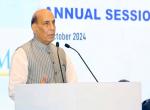The ruthless attack by Maoists on a convoy of Congress leaders and workers at Jeeram Ghati in Jagdalpur district of Chhattisgarh on 25 May 2013 claimed 28 lives and injured scores of others. Those killed included Mahendra Karma, a former Minister of Chhattisgarh and a former Lok Sabha member, Nand Kumar Patel, the state’s Congress chief, his son Dinesh Patel, and former MLA Uday Mudliyar; former Union minister Vidya Charan Shukla and Konta MLA Kawasi Lakhma were critically injured in the barbaric assault. The convoy was an ideal target for the Maoists, who have been looking for chances to attack. It was a perfect target because of the presence of many high-profile leaders in one place, and that too with less security cover, passing through a most vulnerable area. Assessing the incident, some key issues are worth examining.
It is surprising why so many top leaders decided to travel together in one convoy on a route that traverses through areas dominated by Maoists. The convoy was huge, comprising about 25 vehicles, thus limiting their mobility and get-away in case of an ambush or even on a slight disruption. The Standard Operating Procedures (SOPs) were simply ignored. The route was indeed sanitised, but only cosmetically. There was no area domination exercise, neither were there attempts to use Unmanned Aerial Vehicles (UAVs) to monitor the convoy route. As the State goes to polls by this year end, both Congress and the ruling BJP had begun their electoral campaigns. While the Congress named its campaign ‘Parivartan (Change) Yatra’, the BJP termed its electoral drive ‘Vikas (Development) Yatra’. The State Congress, however, has been desperate to win this time. Accordingly, it did not want to be deterred by Maoists’ threats and wished to canvass in almost all areas of the State, including in the so-called “liberated zones”. Perhaps, it is for this reason that the State’s Congress chief, N. K. Patel, had not been critical of Maoists of late. Out of 26 seats in the tribal belt of the State, the Congress has only three in the current Assembly. The party wanted to improve on this tally. Seen in this context, one can understand the State Congress leadership’s overt attempt to keep a distance from the ongoing anti-Naxal operations and security forces. This also partly explains the presence of less number of uniformed security personnel during the campaign in general, and in the convoy in particular. The State Congress leaders might have believed that even Maoists wanted the present BJP government in Chhattisgarh to be replaced by the Congress. They have sadly mistaken the Maoists’ ideology, which wants to overthrow all democratically elected governments. By this attack, the Maoists have also sent a clear message: keep off tribal areas.
Were there enough intelligence inputs on the attacks? There were, indeed, intelligence alerts, but most generic in nature. But, one wonders how even a general build-up before the attack of this magnitude has gone unnoticed. Most importantly, attacks from Maoists are anticipated during this part of the year when trees shed maximum part of their green before monsoon sets in. Moreover, due to upcoming elections in the State, Maoists are out to deter and disrupt election campaigns to undermine any democratic process. Maoists also had their own reasons to attack each of the Congress leaders who were part of the convoy. In a four page note sent to the media houses, a spokesperson of Dandkaranya Vishesh Zonal Committee, Gudsa Usendi, noted that Nand Kumar Patel was targeted because he approved ‘Operation Green Hunt’ when he was Chhattisgarh’s Home Minister; and Mahendra Karma was “punished” for his “misdeeds” as the founder of the Salwa Judum. In fact, Mahendra Karma, who was under ‘Z-plus’ security cover, was high on the Maoists’ hit list having escaped their attack five times earlier. This time he was not lucky. Going by the Maoists’ note, they would target any political leadership in the State and beyond “for their anti-people policies” in the coming days. The Maoists also were talking of extracting revenge for the collateral damages to the tribals and direct Maoist casualties in the ongoing anti-Naxal operation. Many more attacks are expected, especially to deter electoral campaigns. The recent trends of Maoists’ tactical counter offensive campaigns clearly show that they are looking at soft targets as well.
Despite the presence of so many leaders in the convoy, the number of security personnel, including personal security officers (PSOs) was less. Even ‘Z-plus’ security cover was not optimum – just 16 out of 28 were present for Mahendra Karma. There were a total of about 50 security personnel as against about 200 Maoists – an unmanageable ratio of 1:4. The way the ambush was handled clearly shows that fitness and fighting ability of even those 50 security personnel were not up-to-the-mark. There was no single commander to direct the security personnel to fight against the ambushers. It was a free for all. The quality and amount of weapons and ammunition available with the security personnel were also not adequate. Some weapons reportedly got jammed due to poor maintenance. Therefore, the convoy was both outnumbered and outgunned. It took several hours for the reinforcements to reach the place for various reasons: lack of spare forces; fear of landmines on all the approach roads; and absence of a system to rush troops through helicopters.
The incident also highlighted poor coordination between the State and Central forces. The routine security review meeting that takes place before any major convoy movement did not take place. The Central forces were informed of the movement of the Congress leaders by the local police only the previous evening. The requisite synergy was missing. Well planned and coordinated approach between the State and Central forces could have avoided the bloody tragedy.
All these points should come out clearly in the ongoing National Intelligence Agency (NIA) probe on the incident. The ensuing report, instead of gathering dust in due course as is the case with most such documents, must be acted upon. It should fix responsibility, cover gaps and disseminate lessons learnt so that no such incident occurs in the future.
Published Date: 3rd June 2013









Post new comment